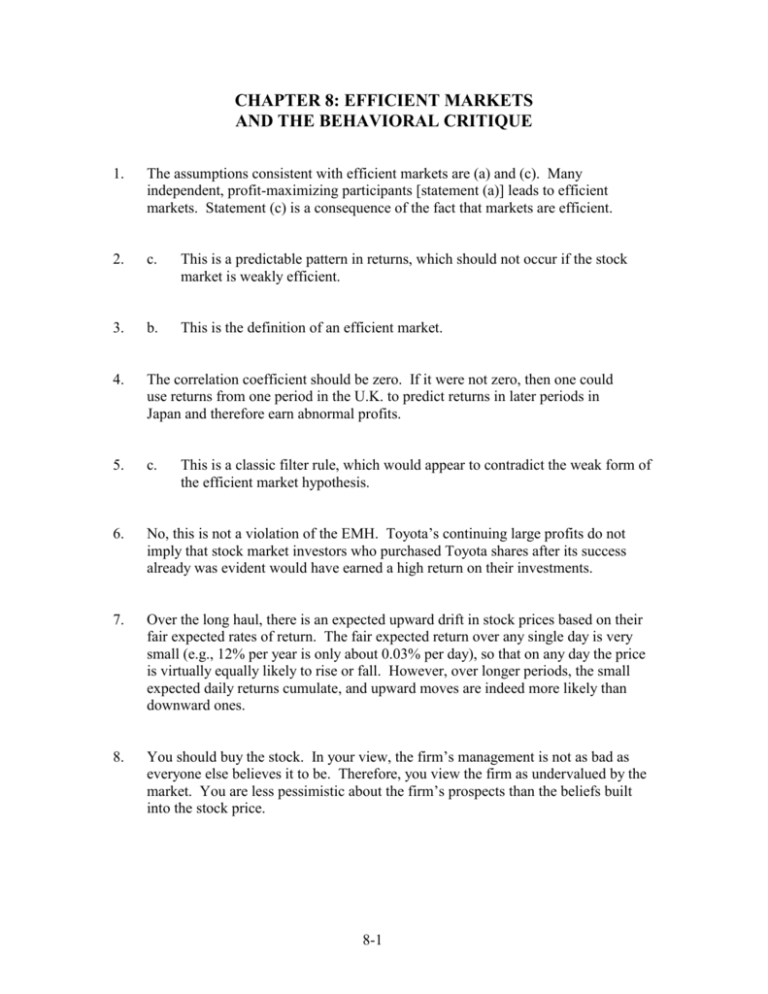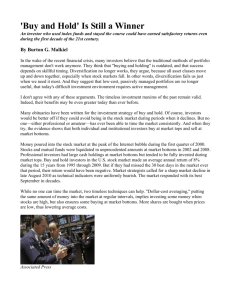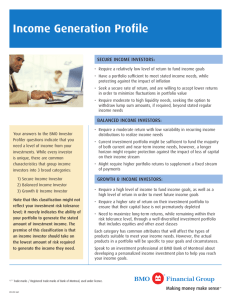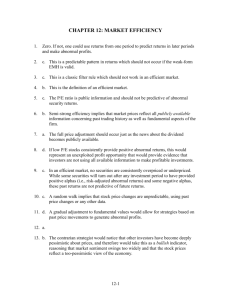CHAPTER 8: MARKET EFFICIENCY
advertisement

CHAPTER 8: EFFICIENT MARKETS AND THE BEHAVIORAL CRITIQUE 1. The assumptions consistent with efficient markets are (a) and (c). Many independent, profit-maximizing participants [statement (a)] leads to efficient markets. Statement (c) is a consequence of the fact that markets are efficient. 2. c. This is a predictable pattern in returns, which should not occur if the stock market is weakly efficient. 3. b. This is the definition of an efficient market. 4. The correlation coefficient should be zero. If it were not zero, then one could use returns from one period in the U.K. to predict returns in later periods in Japan and therefore earn abnormal profits. 5. c. 6. No, this is not a violation of the EMH. Toyota’s continuing large profits do not imply that stock market investors who purchased Toyota shares after its success already was evident would have earned a high return on their investments. 7. Over the long haul, there is an expected upward drift in stock prices based on their fair expected rates of return. The fair expected return over any single day is very small (e.g., 12% per year is only about 0.03% per day), so that on any day the price is virtually equally likely to rise or fall. However, over longer periods, the small expected daily returns cumulate, and upward moves are indeed more likely than downward ones. 8. You should buy the stock. In your view, the firm’s management is not as bad as everyone else believes it to be. Therefore, you view the firm as undervalued by the market. You are less pessimistic about the firm’s prospects than the beliefs built into the stock price. This is a classic filter rule, which would appear to contradict the weak form of the efficient market hypothesis. 8-1 9. No, this is not a violation of the EMH. This empirical tendency does not provide investors with a tool that will enable them to earn abnormal returns; in other words, it does not suggest that investors are failing to use all available information. An investor could not use this phenomenon to choose undervalued stocks today. The phenomenon instead reflects the fact that stock splits occur as a response to good performance (i.e., positive abnormal returns) which drives up the stock price above a desired "trading range" and then leads managers to split the stock. After the fact, the stocks that happen to have performed the best will be split candidates, but this does not imply that you can identify the best performers early enough to earn abnormal returns. 10. While positive beta stocks respond well to favorable new information about the economy’s progress through the business cycle, these should not show abnormal returns around already anticipated events. If a recovery, for example, is already anticipated, the actual recovery is not news. The stock price should already reflect the coming recovery. 11. Expected rates of return differ because of differential risk premiums. 12. The market responds positively to new news. If the eventual recovery is anticipated, then the recovery is already reflected in stock prices. Only a better-than-expected recovery (or a worse-than-expected recovery) should affect stock prices. 13. d. 14. c. 15. The P/E ratio is public information so this observation would provide evidence against the semistrong form of the efficient market theory. Assumptions supporting passive management are: a. informational efficiency b. primacy of diversification motives Active management is supported by the opposite assumptions, in particular, that pockets of market inefficiency exist. 8-2 16. a. The grandson is recommending taking advantage of (i) the small firm anomaly and (ii) the January anomaly. In fact, this seems to be one anomaly: the smallfirm-in-January anomaly. b. (i) Concentration of one’s portfolio in stocks having very similar attributes may expose the portfolio to more risk than is desirable. The strategy limits the potential for diversification. (ii) Even if the study results are correct as described, each such study covers a specific time period. There is no assurance that future time periods would yield similar results. (iii) After the results of the studies became publicly known, investment decisions might nullify these relationships. If these firms in fact offered investment bargains, their prices may be bid up to reflect the now-known opportunity. 17. a. Consistent. Half of all managers should outperform the market based on pure luck in any year. b. Violation. This would be the basis for an "easy money" rule: simply invest with last year's best managers. c. Consistent. Predictable volatility does not convey a means to earn abnormal returns. d. Violation. The abnormal performance ought to occur in January, when the increased earnings are announced. e. Violation. Reversals offer a means to earn easy money: simply buy last week's losers. 18. Implicit in the dollar-cost averaging strategy is the notion that stock prices fluctuate around a “normal” level. Otherwise, there is no meaning to statements such as: “when the price is high.” How do we know, for example, whether a price of $25 today will be viewed as high or low compared to the stock price in six months from now? 19. a. The efficient market hypothesis (EMH) states that a market is efficient if security prices immediately and fully reflect all available relevant information. If the market fully reflects information, the knowledge of that information would not allow an investor to profit from the information because stock prices already incorporate the information. 8-3 i. The weak form of the EMH asserts that stock prices reflect all the information that can be derived by examining market trading data such as the history of past prices and trading volume. A strong body of evidence supports weak-form efficiency in the major U.S. securities markets. For example, test results suggest that technical trading rules do not produce superior returns after adjusting for transaction costs and taxes. ii. The semistrong form states that a firm’s stock price reflects all publicly available information about a firm’s prospects. Examples of publicly available information are company annual reports and investment advisory data. Evidence strongly supports the notion of semistrong efficiency, but occasional studies (e.g., those identifying market anomalies such as the small-firm-inJanuary or book-to-market effects) and events (such as the stock market crash of October 19, 1987) are inconsistent with this form of market efficiency. However, there is a question concerning the extent to which these “anomalies” result from data mining. iii. The strong form of the EMH holds that current market prices reflect all information (whether publicly available or privately held) that can be relevant to the valuation of the firm. Empirical evidence suggests that strong-form efficiency does not hold. If this form were correct, prices would fully reflect all information. Therefore even insiders could not earn excess returns. But the evidence is that corporate officers do have access to pertinent information long enough before public release to enable them to profit from trading on this information. b. i. Technical analysis involves the search for recurrent and predictable patterns in stock prices in order to enhance returns. The EMH implies that technical analysis is without value. If past prices contain no useful information for predicting future prices, there is no point in following any technical trading rule. ii. Fundamental analysis uses earnings and dividend prospects of the firm, expectations of future interest rates, and risk evaluation of the firm to determine proper stock prices. The EMH predicts that most fundamental analysis is doomed to failure. According to semistrong-form efficiency, no investor can earn excess returns from trading rules based on publicly available information. Only analysts with unique insight achieve superior returns. In summary, the EMH holds that the market appears to adjust so quickly to information about both individual stocks and the economy as a whole that no technique of selecting a portfolio using either technical or fundamental analysis can consistently outperform a strategy of simply buying and holding a diversified portfolio of securities, such as those comprising the popular market indexes. 8-4 20. 21. c. Portfolio managers have several roles and responsibilities even in perfectly efficient markets. The most important responsibility is to identify the risk/return objectives for a portfolio given the investor’s constraints. In an efficient market, portfolio managers are responsible for tailoring the portfolio to meet the investor’s needs, rather than to beat the market, which requires identifying the client’s return requirements and risk tolerance. Rational portfolio management also requires examining the investor’s constraints, including liquidity, time horizon, laws and regulations, taxes, and unique preferences and circumstances such as age and employment. a. The earnings (and dividend) growth rates of growth stocks may be consistently overestimated by investors. Investors may extrapolate recent earnings (and dividend) growth too far into the future and thereby downplay the inevitable slowdown. At any given time, growth stocks are likely to revert to (lower) mean returns and value stocks are likely to revert to (higher) mean returns, often over an extended future time horizon. b. In efficient markets, the current prices of stocks already reflect all known, relevant information. In this situation, growth stocks and value stocks provide the same risk-adjusted expected return. a. Some empirical evidence that supports the EMH is: (i) professional money managers do not typically earn higher returns than comparable risk, passive index strategies; (ii) event studies typically show that stocks respond immediately to the public release of relevant news; (iii) most tests of technical analysis find that it is difficult to identify price trends that can be exploited to earn superior risk-adjusted investment returns. b. Some evidence that is difficult to reconcile with the EMH concerns simple portfolio strategies that apparently would have provided high risk-adjusted returns in the past. Some examples of portfolios with attractive historical returns: (i) (ii) (iii) (iv) low P/E stocks; high book-to-market ratio stocks; small firms in January; firms with very poor stock price performance in the last few months. Other evidence concerns post-earnings-announcement stock price drift and intermediate-term price momentum. c. An investor might choose not to index even if markets are efficient because he or she may want to tailor a portfolio to specific tax considerations or to specific risk management issues, for example, the need to hedge (or at least not add to) exposure to a particular source of risk (e.g., industry exposure). 8-5 22. No, it is not more attractive as a possible purchase. Any value associated with dividend predictability is already reflected in the stock price. 23. The market may have anticipated even greater earnings. Compared to prior expectations, the announcement was a disappointment. 24. i. Mental accounting is best illustrated by Statement #3. Sampson’s requirement that his income needs be met via interest income and stock dividends is an example of mental accounting. Mental accounting holds that investors segregate funds into mental accounts (e.g., dividends and capital gains), maintain a set of separate mental accounts, and do not combine outcomes; a loss in one account is treated separately from a loss in another account. Mental accounting leads to an investor preference for dividends over capital gains and to an inability or failure to consider total return. ii. Overconfidence (illusion of control) is best illustrated by Statement #6. Sampson’s desire to select investments that are inconsistent with his overall strategy indicates overconfidence. Overconfident individuals often exhibit risk-seeking behavior. People are also more confident in the validity of their conclusions than is justified by their success rate. Causes of overconfidence include the illusion of control, self-enhancement tendencies, insensitivity to predictive accuracy, and misconceptions of chance processes. iii. Reference dependence is best illustrated by Statement #5. Sampson’s desire to retain poor performing investments and to take quick profits on successful investments suggests reference dependence. Reference dependence holds that investment decisions are critically dependent on the decision-maker’s reference point. In this case, the reference point is the original purchase price. Alternatives are evaluated not in terms of final outcomes but rather in terms of gains and losses relative to this reference point. Thus, preferences are susceptible to manipulation simply by changing the reference point. 25. a. Frost's statement is an example of reference dependence. His inclination to sell the international investments once prices return to the original cost depends not only on the terminal wealth value, but also on where he is now, that is, his reference point. This reference point, which is below the original cost, has become a critical factor in Frost’s decision. In standard finance, alternatives are evaluated in terms of terminal wealth values or final outcomes, not in terms of gains and losses relative to some reference point such as original cost. 8-6 b. Frost’s statement is an example of susceptibility to cognitive error, in at least two ways. First, he is displaying the behavioral flaw of overconfidence. He likely is more confident about the validity of his conclusion than is justified by his rate of success. He is very confident that the past performance of Country XYZ indicates future performance. Behavioral investors could, and often do, conclude that a five-year record is ample evidence to suggest future performance. Second, by choosing to invest in the securities of only Country XYZ, Frost is also exemplifying the behavioral finance phenomenon of asset segregation. That is, he is evaluating Country XYZ investment in terms of its anticipated gains or losses viewed in isolation. Individuals are typically more confident about the validity of their conclusions than is justified by their success rate or by the principles of standard finance, especially with regard to relevant time horizons. In standard finance, investors know that five years of returns on Country XYZ securities relative to all other markets provide little information about future performance. A standard finance investor would not be fooled by this “law of small numbers.” In standard finance, investors evaluate performance in portfolio terms, in this case defined by combining the Country XYZ holding with all other securities held. Investments in Country XYZ, like all other potential investments, should be evaluated in terms of the anticipated contribution to the risk- reward profile of the entire portfolio. c. Frost’s statement is an example of mental accounting. Mental accounting holds that investors segregate money into mental accounts (e.g., safe versus speculative), maintain a set of separate mental accounts, and do not combine outcomes; a loss in one account is treated separately from a loss in another account. One manifestation of mental accounting, in which Frost is engaging, is building a portfolio as a pyramid of assets, layer by layer, with the retirement account representing a layer separate from the “speculative” fund. Each layer is associated with different goals and attitudes toward risk. He is more risk averse with respect to the retirement account than he is with respect to the “speculative” fund account. The money in the retirement account is a down side protection layer, designed to avoid future poverty. The money in the “speculative” fund account is the upside potential layer, designed for a chance at being rich. In standard finance, decisions consider the risk and return profile of the entire portfolio rather than anticipated gains or losses on any particular account, investment, or class of investments. Alternatives should be considered in terms of final outcomes in a total portfolio context rather than in terms of contributions to a “safe” or a “speculative” account. Standard finance investors seek to maximize the mean-variance structure of the portfolio as a whole and consider covariances between assets as they construct their portfolios. Standard finance investors have consistent attitudes toward risk across their entire portfolio. 8-7







